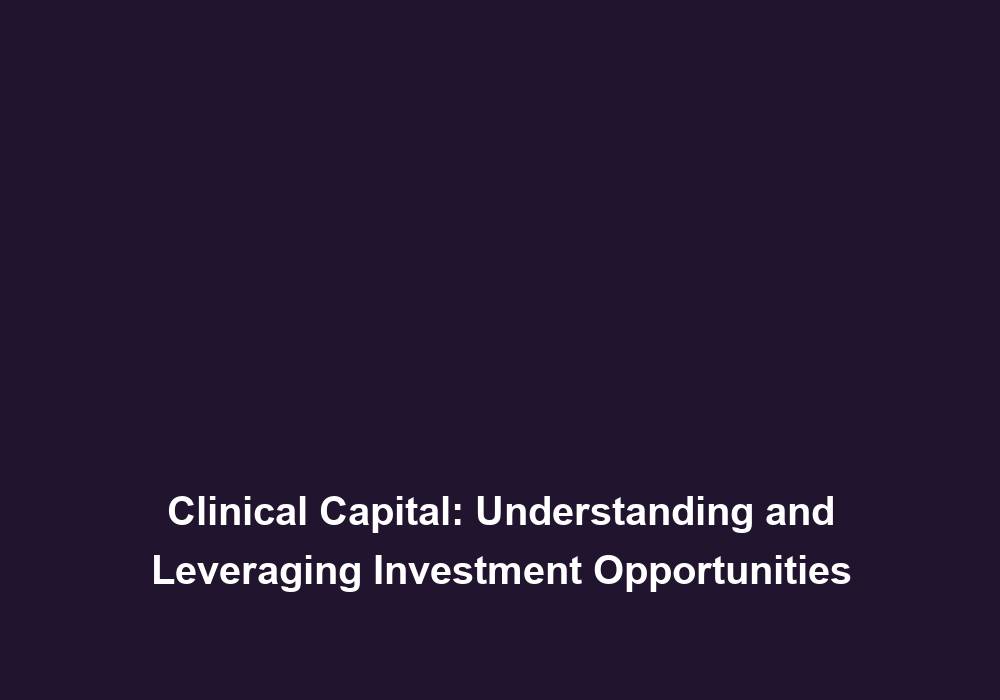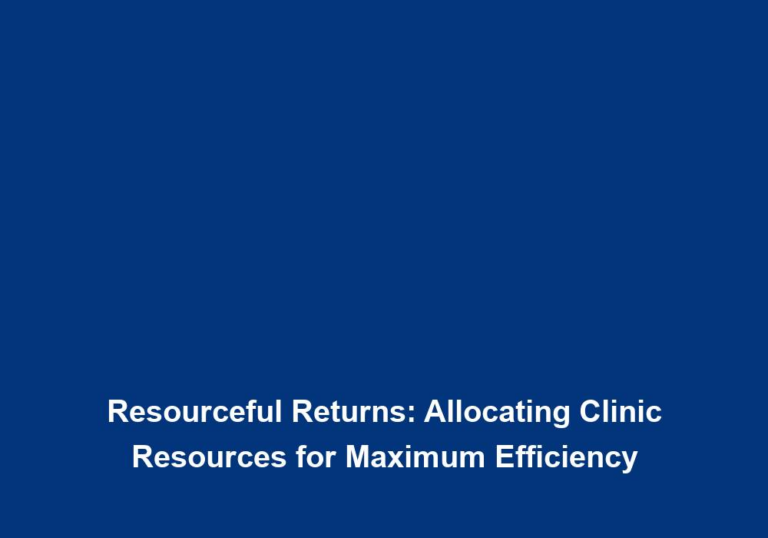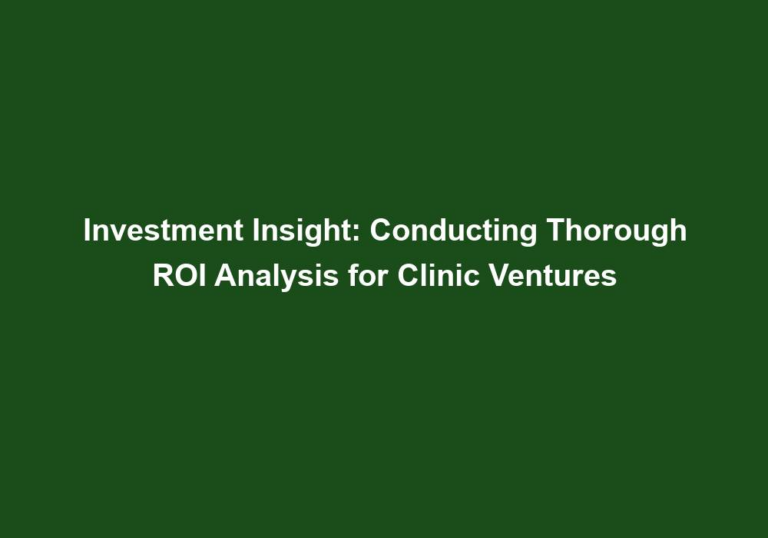Growing Gold: Investment Strategies for Modern Medical Practices
In today’s ever-evolving healthcare industry, medical practices are not just focused on providing excellent patient care but also on achieving financial stability and growth. Investing wisely can be a key factor in achieving long-term success for modern medical practices. This article aims to provide valuable insights and investment strategies that can help medical professionals make informed decisions to grow their practice’s wealth.
Understanding the Importance of Investment for Medical Practices
Investing in the right opportunities can yield significant financial rewards for medical practices. Here are a few reasons why investing is crucial for their growth:
- Diversification of Revenue Streams: By investing, medical practices can generate additional income streams, reducing their reliance solely on patient fees and insurance reimbursements. This diversification can provide stability during challenging financial times.
Investing in different areas such as real estate, stocks, bonds, and peer-to-peer lending can provide medical practices with a diverse range of revenue streams. This not only reduces their dependence on patient fees but also helps them navigate economic downturns more effectively.
- Funding Expansion and Upgrades: Investments can be utilized to expand facilities, invest in state-of-the-art medical equipment, or implement advanced technologies. These enhancements can attract more patients and increase revenue.
Medical practices can use their investment returns to fund expansion projects, such as opening new clinics or acquiring additional medical equipment. Investing in advanced technologies can also improve patient care and attract a larger patient base, ultimately boosting revenue.
- Retirement Planning: Medical professionals often face unique retirement challenges due to the nature of their work. Investing early in their careers allows them to build a substantial nest egg and retire comfortably.
Investing in retirement accounts, such as 401(k) and 403(b) plans, allows medical professionals to maximize their retirement savings. By taking advantage of pre-tax contributions and potential employer matches, they can ensure a comfortable retirement after years of dedicated service.
Investment Strategies Tailored for Medical Practices
Developing an investment strategy is crucial to optimize financial growth and mitigate risks. Here are some effective investment strategies that medical practices can consider:
1. Real Estate Investments
Investing in real estate can be an excellent long-term strategy for medical practices. Consider the following options:
- Medical Office Space: Owning the space where your practice operates can provide stability, reduce rental costs, and potentially generate rental income from other healthcare professionals.
By owning the space where the medical practice operates, practitioners can control their overhead costs and have more flexibility in managing their practice. Additionally, renting out surplus space to other healthcare professionals can create an additional revenue stream.
- Commercial Real Estate: Investing in commercial properties such as medical plazas or multi-tenant buildings can provide additional revenue streams through leasing to other healthcare providers.
Diversifying real estate investments beyond the practice’s own office space can further enhance revenue generation. Investing in medical plazas or multi-tenant buildings allows medical practices to lease space to other healthcare providers, creating a consistent income stream.
2. Stocks and Bonds
While investing in the stock market carries some risks, it can also offer substantial returns. Consider these options:
- Healthcare Sector: Investing in healthcare-related stocks can provide opportunities for growth, especially with the constant demand for medical services.
As medical professionals, investing in the healthcare sector can offer a unique advantage. By leveraging their expertise and industry knowledge, medical practitioners can identify promising healthcare companies and invest in their growth potential.
- Blue-Chip Stocks: Investing in well-established, financially stable companies across various sectors can provide a reliable income stream and potential capital appreciation.
Diversifying investment portfolios with blue-chip stocks can help mitigate risks. These stocks are typically associated with large, stable companies that have a proven track record of generating steady income and providing consistent dividends.
- Bonds: Consider investing in government or corporate bonds, which offer fixed interest payments over a specified period, providing a predictable income stream.
Bonds can serve as a stable investment option, providing a fixed income stream. Government bonds are considered low-risk, while corporate bonds offer potentially higher returns. Including bonds in a medical practice’s investment portfolio can provide stability and balance against more volatile investments.
3. Retirement Accounts
Maximizing retirement accounts is essential for medical professionals due to the high income potential during their careers. Consider the following retirement planning options:
- 401(k) and 403(b) Plans: Contribute the maximum allowed amount to these employer-sponsored retirement plans to benefit from pre-tax contributions and potential employer match programs.
By taking advantage of employer-sponsored retirement plans, medical professionals can significantly increase their retirement savings. The pre-tax contributions and potential employer matches provide an opportunity for accelerated growth in retirement accounts.
- Individual Retirement Accounts (IRAs): Consider traditional or Roth IRAs to supplement employer-sponsored plans and enjoy potential tax advantages.
Individual Retirement Accounts (IRAs) offer additional avenues for retirement savings. Traditional IRAs allow for tax-deductible contributions, while Roth IRAs offer tax-free withdrawals in retirement. Medical professionals can utilize both types of IRAs to diversify their retirement savings and optimize tax advantages.
4. Peer-to-Peer Lending
Peer-to-peer lending platforms enable medical practices to lend money directly to individuals or businesses in need. This investment strategy can provide attractive interest rates and diversification. However, thorough research and due diligence are essential to minimize risks.
Peer-to-peer lending can be a viable investment option for medical practices looking to diversify their portfolios and generate passive income. By lending directly to borrowers, medical practices can earn attractive interest rates and potentially achieve higher returns compared to traditional investments. However, it is crucial to conduct thorough research and due diligence to minimize the risk of defaults.
5. Continuing Education and Skill Enhancement
Investing in professional development and acquiring new skills is equally crucial for medical professionals. By staying updated with the latest medical advancements and techniques, practitioners can attract more patients, expand their practice, and increase their earning potential.
Continuing education plays a vital role in the success of medical practices. By investing in professional development, medical professionals can enhance their skills, stay abreast of industry trends, and provide the highest quality of care to their patients. This not only helps in attracting a larger patient base but also creates opportunities for practice expansion and increased revenue.
Risk Management and Professional Advice
While investing is crucial for growing a medical practice, it’s essential to manage risks effectively. Here are some tips to mitigate potential risks:
- Diversification: Avoid putting all your eggs in one basket. Diversify your investment portfolio across various asset classes to reduce exposure to a single investment’s performance.
Diversification is key to managing investment risks. By spreading investments across different asset classes, such as stocks, bonds, real estate, and peer-to-peer lending, medical practices can reduce their exposure to the volatility of any one investment.
- Expert Guidance: Seek guidance from financial advisors who specialize in working with medical professionals. They can provide tailored advice considering your unique financial goals, risk tolerance, and tax implications.
Consulting with experienced financial advisors who understand the specific needs and challenges of medical professionals can help in developing a customized investment strategy. These advisors can offer valuable insights, assess risk tolerance, and provide guidance on tax-efficient investment solutions.
- Stay Informed: Keep yourself updated with market trends, regulatory changes, and economic indicators. This knowledge will help you make informed investment decisions.
Staying informed about market trends, regulatory changes, and economic indicators is crucial in making sound investment decisions. By staying updated, medical professionals can adapt their investment strategies to changing market conditions and take advantage of emerging opportunities.
- Regular Portfolio Review: Conduct periodic reviews of your investment portfolio to ensure it aligns with your changing financial goals and market conditions.
Regularly reviewing the investment portfolio is essential to ensure it remains aligned with the medical practice’s evolving financial goals and market conditions. Periodic reviews allow for adjustments and rebalancing to optimize investment performance and manage risks effectively.
Disclaimer: This article is for informational purposes only and does not constitute financial or investment advice. Consult with a licensed financial advisor before making any investment decisions.
In conclusion, investing wisely is crucial for the long-term financial growth of modern medical practices. By considering diverse investment opportunities, managing risks, and seeking professional advice, medical professionals can create additional revenue streams, fund expansion, and secure a comfortable retirement. Remember, thorough research and continuous professional development are essential in making informed investment decisions.






